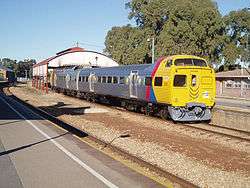2000 class railcar
| 2000/2100 class railcars | |
|---|---|
 | |
| Manufacturer | Comeng |
| Built at | Granville |
| Entered service | 1979-1980 |
| Scrapped | 2016 |
| Number built | 30 |
| Number preserved | 6 |
| Number scrapped | 24 |
| Formation | 2/3 carriages |
| Fleet numbers |
2001-2012 2101-2118 |
| Capacity |
72 (2000) 104 (2100) |
| Operator(s) |
State Transport Authority TransAdelaide Adelaide Metro |
| Depot(s) | Dry Creek |
| Specifications | |
| Car length | 24.8 metres |
| Width | 3.19 metres |
| Height | 4.27 metres |
| Maximum speed |
130 km/h (81 mph) 90 km/h (56 mph) Network Speed |
| Weight |
65 tonnes (2000) 42 tonnes (2100) |
| Prime mover(s) |
As built: 2 x MAN D3650s After repowering: 2 x Cummins KTA 19Rs |
| Power output |
As built: 2 x 377 kW (506 hp) After repowering: 2 x 390 kW (520 hp) |
| Transmission | Voith T420r Diesel Hydraulic |
| Auxiliaries | Rolls-Royce SF65CT |
| Track gauge | 1,600 mm (5 ft 3 in) |
The 2000/2100 class were a class of diesel railcars operated by the State Transport Authority and its successors in Adelaide. They were built by Comeng, Granville in 1979-1980.
History
The 2000/2100 class were self-propelled diesel railcars operated by the State Transport Authority and its successors on the Adelaide rail network. The body shell design was based on the Budd SPV-2000, Metroliner and Amfleet cars but the 2000 class railcars have a slightly different curve to the Amfleet.[1]
Twelve 2000 powercars and eighteen 2100 class trailer cars were built. The bodyshells were built by Comeng, Granville. Two (2001 and 2101) were completed at Granville while the remainder were railed to Adelaide via Lithgow and Broken Hill to comply with a contractual requirement to maximise local content, the fit out being conducted at Comeng's Dry Creek facility.[2] The first entered service in February 1980.[3][4]
They were nicknamed Jumbos due to the raised driving cab, similar to that of the Boeing 747. This raised cab was designed to meet Australian Federated Union of Locomotive Employees demands for a full width driver's cab whilst allowing inter-carriage doors to be fitted.[5][6]
The powercars were originally powered by V12 turbocharged MAN engines that were late replaced by two turbocharged 6 cylinder Cummins engines under the floor driving a Voith hydraulic transmission. They usually operated in 2-car (power-trailer) or 3-car (trailer-power-trailer) configurations. It was originally intended that they primarily operate express services on the Gawler and Noarlunga Centre lines with the existing Redhens operating the all stops services, but they quickly ended up operating services across the network.[1][4]
Six were stored for a number of years, being returned to traffic in 2007.[7][8] One was sent to Bombardier Transportation's Dandenong factory in 2006 to assess the feasibility of a life extension program, but it was deemed not worthwhile.[9] They did on occasions venture beyond the Adelaide metropolitan area, operating special services to Tanunda and Nuriootpa on the Barossa Valley line.[10][11]
From February 2014, they were no longer permitted to operate on the Belair and Seaford lines due to low clearances as a result of the electrification of these lines, being restricted to the Gawler, Grange, Outer Harbor lines. Mass withdrawals commenced in 2014 as the 4000 class electric multiple units entered service.[12][13][14] The last was retired in August 2015.[9][15]
Preservation
Four have been preserved:[9][16]
- 2006 and 2112 by the National Railway Museum, Port Adelaide[17]
- 2010 and 2109 by SteamRanger[18]
In addition, both 2009 (cut in half) and 2104 were donated to the South Australian Metropolitan Fire Service for training.[16] The rest were scrapped in June 2016 by Simsmetal, Port Adelaide.[9][19][20]
References
- 1 2 McNicol, Steve (2016). Jumbos: The early days. Elzabeth: Railmac Publications. ISBN 9781864771121.
- ↑ "Here & There" Australian Railway Historical Society Bulletin issue 507 January 1980 page 4
- ↑ "Here & There" Australian Railway Historical Society Bulletin issue 511 May 1980 page 27
- 1 2 "2000 Class Railcars" Australian Railway Historical Society Bulletin issue 605 Match 1988 pages 50-69
- ↑ "The Adelaide 2000 class Railcars" Railway Digest December 2005 pages 32/33
- ↑ Dunn, John (2013). Comeng: A History of Commonwealth Engineering Volume 4: 1977-1985. Kenthurst: Rosenberg Publishing. pp. 16–30. ISBN 9781922013514.
- ↑ "TransAdelaide Update" Catch Point issue 173 May 2006 page 5
- ↑ "Gawler Line Timetable Changes" Catch Point issue 187 September 2008 page 17
- 1 2 3 4 McNicol, Steve (2017). Jumbos: Workhorses to the end. Elzabeth: Railmac Publications. ISBN 9781864771145.
- ↑ "Broad Gauge - Northern Lines" Catch Point issue 113 May 1996 page 22
- ↑ "TransAdelaide Barossa Services" Catch Point issue 117 January 1997 page 8
- ↑ "Seaford Rail Extension opens for business" Railway Digest April 2014 page 16
- ↑ "Limited life for 2000 class Jumbo railcars" Railway Digest January 2015 page 20
- ↑ "Adelaide Metropolitan News" Catch Point March 2015 page 14
- ↑ "Jumbos Finally Sign Off" Catch Point issue 234 September 2015 page 6
- 1 2 "SA Jumbos Preserved" Railway Digest January 2016 page 57
- ↑ Annual Report for year ended 30 June 2016 National Railway Museum
- ↑ SHR gains some more heritage rolling stock SteamRanger
- ↑ Scrapped railcars needed to help Adelaide's struggling rail network, enthusiasts say ABC News 1 June 2016
- ↑ "Jumbo Railcars Say Farewell" Catch Point issue 234 July 2016 pages 10-13
External links
![]()